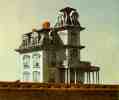
 Hopper, Edward
Hopper, Edward
 House by the Railroad
House by the Railroad
1925 (130 Kb); Oil on canvas, 60.9 x 73.6 cm (24 x 29 in)
Hopper frequently used a straight. horizontal motif, usually a road or
railroad track. to construct the space within the picture and to
emphasize the division between the picture space and the viewer's
world. Indeed, the more the viewer tries to penetrate the depths of a
Hopper painting, the more impenetrable it becomes. What holds the
viewer is that the artist's vision seems under control and yet, on
closer inspection, the viewer realizes that the visible surface is a
tissue of improbabilities and unreadable shifts in space. Hopper's
view that nature and the contemporary world were incoherent
contributed to his artistic vision.
- Indications of the structure of the house were brushed in with a
minimum of black paint in a turpentine mixture. The columns and
windows on the right shadowed side of the house clearly show this.
- The house was then painted from dark to light: Hopper gradually
added more oil paint to the turpentine and built up the forms with
free, often diagonal brushwork.
- The side of the house in bright sunlight was executed less freely
with transparent darks and opaque lights. Lines of blue were added
after the opaque white to define forms.
- The railway line and embankment were also executed from dark to
light. The orange and ochres on the bed of the track are virtually
impasto with short brushstrokes applied in various directions.
- Although the sky may well have been indicated from the start of the
painting, it appears to have been brushed around the form of the house
and may have been the final part of Hopper's painting procedure. In
the blue areas, the paint is thin with the grain of the canvas clearly
visible. White areas were applied more thickly, but not as thick as
those of the house, and brushstrokes are visible.
� 14 Jul 2002,
Nicolas Pioch -
Top -
Up -
Info
Thanks to the
BMW Foundation, the WebMuseum
mirrors,
partners and contributors
for their support.
 House by the Railroad
House by the Railroad
 House by the Railroad
House by the Railroad